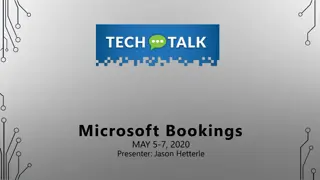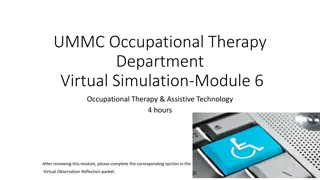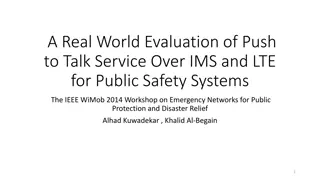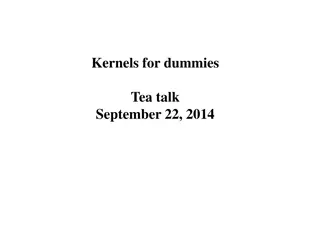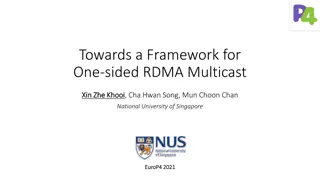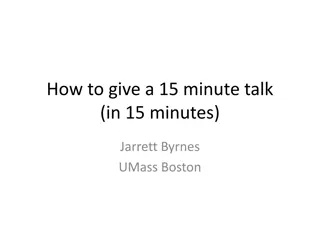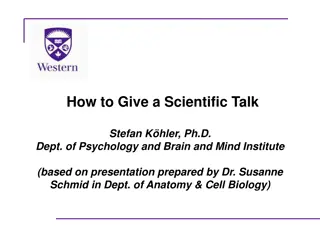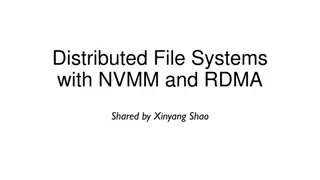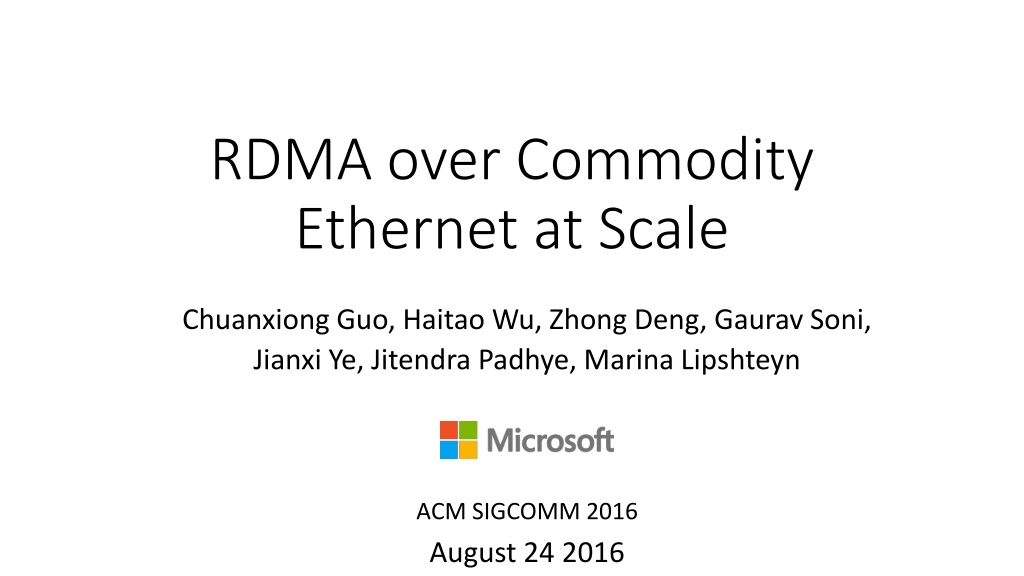
RDMA over Commodity Ethernet at Scale - Challenges and Solutions
Explore the implementation of RDMA over Commodity Ethernet at scale, addressing issues like safety challenges, PFC deadlock, and livelock. Learn about priority-based flow control, DSCP-based PFC, and experiences from related work in this field.
Download Presentation

Please find below an Image/Link to download the presentation.
The content on the website is provided AS IS for your information and personal use only. It may not be sold, licensed, or shared on other websites without obtaining consent from the author. Download presentation by click this link. If you encounter any issues during the download, it is possible that the publisher has removed the file from their server.
E N D
Presentation Transcript
RDMA over Commodity Ethernet at Scale Chuanxiong Guo, Haitao Wu, Zhong Deng, Gaurav Soni, Jianxi Ye, Jitendra Padhye, Marina Lipshteyn ACM SIGCOMM 2016 August 24 2016
Outline RDMA/RoCEv2 background DSCP-based PFC Safety challenges RDMA transport livelock PFC deadlock PFC pause frame storm Slow-receiver symptom Experiences and lessons learned Related work Conclusion 2
RDMA/RoCEv2 background RDMA addresses TCP s latency and CPU overhead problems RDMA: Remote Direct Memory Access RDMA offloads the transport layer to the NIC RDMA needs a lossless network RoCEv2: RDMA over commodity Ethernet DCQCN for connection-level congestion control PFC for hop-by-hop flow control RDMA app RDMA app User RDMA verbs RDMA verbs TCP/IP TCP/IP Kernel NIC driver NIC driver RDMA transport IP Ethernet RDMA transport IP Hardware DMA DMA Ethernet Lossless network 3
Priority-based flow control (PFC) Ingress port Egress port Data packet Hop-by-hop flow control, with eight priorities for HOL blocking mitigation The priority in data packets is carried in the VLAN tag PFC pause frame to inform the upstream to stop p0 p1 p0 p1 p0 p1 p7 PFC pause frame p7 XOFF threshold Data packet PFC pause frame 4
DSCP-based PFC Issues of VLAN-based PFC It breaks PXE boot No standard way for carrying VLAN tag in L3 networks DSCP-based PFC DSCP field for carrying the priority value No change needed for the PFC pause frame Supported by major switch/NIC venders TOR Switch Trunk mode No VLAN tag when PXE boot NIC Data packet PFC pause frame 5
Outline RDMA/RoCEv2 background DSCP-based PFC Safety challenges RDMA transport livelock PFC deadlock PFC pause frame storm Slow-receiver symptom Experiences and lessons learned Related work Conclusion 6
RDMA transport livelock Sender Receiver Receiver Sender RDMA Send 0 RDMA Send 0 RDMA Send 1 RDMA Send 1 Switch Pkt drop rate 1/256 RDMA Send N+1 RDMA Send N+1 RDMA Send N+2 RDMA Send N+2 Sender Receiver NAK N NAK N RDMA Send N RDMA Send 0 RDMA Send N+1 RDMA Send 1 RDMA Send N+2 RDMA Send 2 7 Go-back-N Go-back-0
PFC deadlock Our data centers use Clos network Packets first travel up then go down No cyclic buffer dependency for up-down routing -> no deadlock But we did experience deadlock! Spine Podset Leaf Pod ToR Servers 8
PFC deadlock Preliminaries ARP table: IP address to MAC address mapping MAC table: MAC address to port mapping If MAC entry is missing, packets are flooded to all ports Input ARP table IP MAC TTL IP0 MAC0 2h IP1 MAC1 1h MAC table MAC Port TTL Dst: IP1 MAC0 Port0 10min MAC1 - - Output 9
PFC deadlock Path: {S1, T0, La, T1, S3} Lb Path: {S1, T0, La, T1, S5} La p0 p1 p0 p1 Path: {S4, T1, Lb, T0, S2} PFC pause frames 2 4 3 1 Congested port p2 p3 p3 p4 Ingress port T1 T0 Egress port p0 p1 p1 p0 p2 Dead server Packet drop PFC pause frames Server S5 S1 S3 S2 S4 10
PFC deadlock The PFC deadlock root cause: the interaction between the PFC flow control and the Ethernet packet flooding Solution: drop the lossless packets if the ARP entry is incomplete Recommendation: do not flood or multicast for lossless traffic Call for action: more research on deadlocks 11
NIC PFC pause frame storm A malfunctioning NIC may block the whole network PFC pause frame storms caused several incidents Solution: watchdogs at both NIC and switch sides to stop the storm Spine layer Podset 0 Podset 1 Leaf layer ToRs 0 1 2 3 4 5 6 7 servers Malfunctioning NIC 12
The slow-receiver symptom Server ToR to NIC is 40Gb/s, NIC to server is 64Gb/s But NICs may generate large number of PFC pause frames Root cause: NIC is resource constrained Mitigation Large page size for the MTT (memory translation table) entry Dynamic buffer sharing at the ToR CPU DRAM PCIe Gen3 8x8 64Gb/s QSFP 40Gb/s MTT WQEs ToR QPC Pause frames NIC 13
Outline RDMA/RoCEv2 background DSCP-based PFC Safety challenges RDMA transport livelock PFC deadlock PFC pause frame storm Slow-receiver symptom Experiences and lessons learned Related work Conclusion 14
Latency reduction RoCEv2 deployed in Bing world-wide for one and half years Significant latency reduction Incast problem solved as no packet drops 15
RDMA throughput Achieved 3Tb/s inter-podset throughput Bottlenecked by ECMP routing Close to 0 CPU overhead Using two podsets each with 500+ servers 5Tb/s capacity between the two podsets 16
Latency and throughput tradeoff us L1 L1 L0 L1 T1 T0 S0,23 S1,0 S1,23 S0,0 RDMA latencies increase as data shuffling started Low latency vs high throughput Before data shuffling During data shuffling 17
Lessons learned Deadlock, livelock, PFC pause frames propagation and storm did happen Be prepared for the unexpected Configuration management, latency/availability, PFC pause frame, RDMA traffic monitoring NICs are the key to make RoCEv2 work Loss vs lossless: Is lossless needed? 18
Related work Infiniband iWarp Deadlock in lossless networks TCP perf tuning vs. RDMA 19
Conclusion RoCEv2 has been running safely in Microsoft data centers for one and half years DSCP-based PFC which scales RoCEv2 from L2 to L3 Various safety issues/bugs (livelock, deadlock, PFC pause storm, PFC pause propagation) can all be addressed Future work RDMA for inter-DC communications Understanding of deadlocks in data centers Lossless, low-latency and high-throughput networking Applications adoption 20



